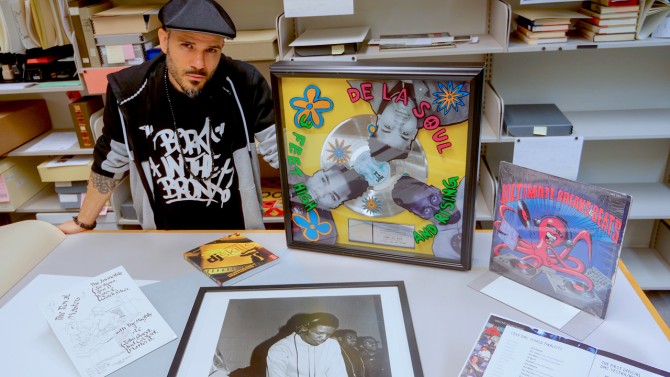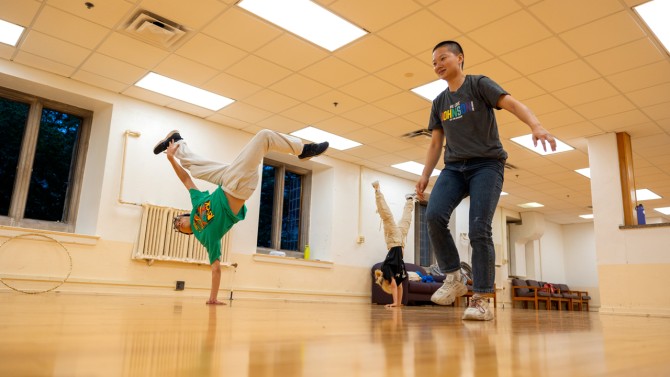From breaking to Beyoncé: Hip Hop Collection empowers students
From breaking to Beyoncé: Hip Hop Collection empowers students
By Caitlin Hayes, Cornell Chronicle
Adedayo Perkovich ’25 grew up listening to her mother’s old school hip-hop albums. She’d watched the 1983 classic “Wild Style” – widely considered the first film to feature hip-hop culture – too many times to count; she wanted to study contemporary music as both a performer and a scholar.
When she was deciding which college to attend, the Cornell Hip Hop Collection, curated by the Cornell University Library, was a major draw.
“It was a big part of why I chose to come here,” said Perkovich, a double major in music and Africana studies in the College of Arts and Sciences. “Getting to connect with the material firsthand and see these parts of history that have influenced so much of what I do today and the music I enjoy today – I just never thought I would have the opportunity to interact with things like that. The fact that Cornell had these materials and were interested in them and promoting them really meant a lot to me.”
Established in 2007, the Hip Hop Collection comprises more than 250,000 items documenting the origins of hip-hop, a cultural movement that took shape in the Bronx in the 1970s but spread quickly around the globe. The largest hip-hop collection in the world, it includes the complete archives of some of the most influential documenters and pioneers of hip-hop, with sound and video recordings, party and event flyers, artwork, photographs, books, magazines and more – all of which is accessible to the public. The collection features materials from all four interconnected pillars of hip-hop: from DJs, rappers, break dancers and graffiti artists.
A current display, in the rotunda of Cornell University Library’s Rare and Manuscript Collections, celebrates the 50th anniversary of hip-hop, and includes flyers and photographs from the archive of Clive Campbell, or DJ Kool Herc, who in 1973 famously linked the percussive sections of different songs together to create a string of energetic “breakbeats” that the crowd could dance to. The occasion has been widely celebrated as the birth of hip-hop.
“The collection has become one of the most distinctive and historically important resources of the university,” said Katherine Reagan, the Ernest L. Stern Curator of Rare Books and Manuscripts in the Cornell University Library Division of Rare and Manuscript Collections, where the Hip Hop Collection is based. “We often hear from faculty that students say it’s one of the most memorable things they’ve experienced at Cornell.”
“That’s humbling,” added Ben Ortiz, collection specialist for the Hip Hop Collection. “Hip-hop can speak to so many different identities and situations and walks of life. The collection is extremely diverse and multigenerational – there are so many aspects of humanity that you can study through this material.”
The scholars
The collection plays an integral role in Professor Riché Richardson’s Beyoncé Nation course; Ortiz introduces the collection on day one, and students visit the archives with him during the semester.
That’s the context in which Perkovich first encountered the collection as a first-year student – she was awed by the materials and their connection to her own experience, including an original drawing of the iconic “Wild Style” logo.
“Ben really makes the collection accessible,” said Richardson, professor of Africana Studies (A&S). “He’ll bring out artifacts related to artists the students really admire, gold albums, sometimes even their clothing or jewelry. He’ll bring out graffiti artists’ black books that students can look through. He really helps them to understand that hip-hop is a multifaceted discourse. Those students who are discovering it for the first time are really blown away and astonished.”
Catherine Appert, associate professor of music (A&S), uses the collection in her Performing Hip Hop and Hip Hop in Global Perspective courses. In addition to being foundational for anyone interested in hip-hop history, she said the collection serves as a tool to teach research practices. “Archival work doesn’t necessarily mean you have to go to the basement of an old church in France to find information about a dead composer,” Appert said. “It shows students that even those of us who work on more contemporary cultural practices can do archival work.”
For many students, the collection also has symbolic meaning – it signals that the university values scholarly work that embraces contemporary popular culture and marginalized artists.
“Having the Hip Hop Collection at Cornell is just really affirming that this kind of study is valid,” said Jessica Ness, a doctoral student in comparative literature who is writing her dissertation on Beyoncé and global modernity. “It makes a statement about the importance of studying Black artists, Black musicians, rappers, dancers, graffiti artists – or any popular culture artists that have been excluded because their work is not considered by some to be rigorous or intellectual.”
Ortiz and Reagan said the collection has been used to study too many topics to mention. “It’s so cross-disciplinary in its relevance,” Reagan said. “It’s music history, art history, the history of dance; it’s urban studies, it’s Africana studies, Latino studies, government studies, American studies. We’ve had architecture classes come to consider if there’s such a thing as hip-hop architecture. People who want to study 1980s fashion. The list goes on.”
In Richardson and Appert’s classes, the collection provides a foundation that allows students to then explore more contemporary artists, like Beyoncé, and the larger global phenomenon of hip-hop.
“Hip-hop from its inception has invited conversations about race, inequality and oppression into the mainstream,” Ness said. “I’ve had really generative conversations with my students about how popular music can actually be revolutionary and conducive to changing perspectives.”
The artists
Student practitioners of hip-hop said the collection supports and enriches a hip-hop community at Cornell, with a number of student organizations dedicated to the genre’s various forms.
Ortiz serves as the adviser for Absolute Zero, Cornell’s student breakdancing club, which historically hosts a visiting artist program each spring; some of the most famous “breakers” in the country have visited Cornell, drawn in part because, in addition to holding workshops, they are invited to explore the collection.
“It’s just such a unique resource,” said Jane Comerford Dexter ’25, a member of Absolute Zero and fashion design and management major in the College of Human Ecology. “We really appreciate that it’s on campus.”
Dexter said her dancing with Absolute Zero has profoundly impacted her experience at Cornell, shaping her social life and her career aspirations – she wants to design clothes for dancers – as well as teaching her about herself.
“The way breaking approaches dance is so important – it teaches you how to improvise, how to express yourself, it connects me to this music that has always empowered me,” she said. “It’s just wonderful.”
Other students have found community around hip-hop in the Music Production Club, for which Ortiz is an informal adviser, and the Hip-Hop Collective, a for-credit course taught by Senegalese rapper Moustapha Fall, where students work collaboratively to produce an album each semester.
“A lot of producers and artists are kind of lone rangers, and it can be hard to find the right match musically,” said James Koga, president of the Music Production Club and computer science major in the College of Arts and Sciences and the Cornell Ann S. Bowers College of Computing and Information Science. “But there are a ton of people looking for this community, and the club and the class are these center points on campus where all the hip-hop artists can come together.”
Having the Hip Hop Collection on campus implicitly encourages students to pursue their passion for a genre that empowers, inspires and connects them, Ness said.
“I feel lucky to be at a school where my own excitement and genuine appreciation for these objects and texts can drive my research,” she said.
“Hip-hop is so amazing,” Koga said. “Its ability to tell a story and the community it invites from all different majors and fields – it’s such a great culture that just brings everybody together. And anybody can find the resources to start in the genre at Cornell – there’s a great community here to help you do that.”
Media Contact
Abby Kozlowski
Get Cornell news delivered right to your inbox.
Subscribe


